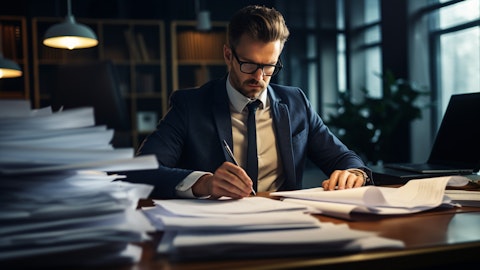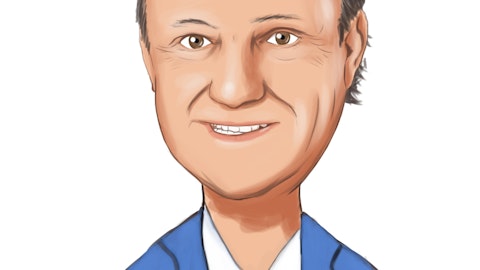Ken Lovik: Actually, we had credit committee meeting this morning, so fresh off the list here. In the non-performing asset side of things, as we mentioned a couple minutes ago, we kind of bumped up reserves in the fourth quarter. Everything that’s sitting in the NPA today is fully reserved. If we have a loss or a write-down, we’ve got a couple SBA loans in there. We have five residential properties. Two of those are from mortgage portfolios we’ve purchased in the past. Three are locally originated by us. So, we’re in good shape coming through the pipeline. We had a little tick up in the actual delinquency during the fourth quarter. That was primarily due to a one — loan. It’s an Urban Air organization, one of our franchise loans, and that’s current.
It was supposed to be paid by quarter-end, didn’t make it. And out of credit committee this morning, we’re not seeing any significant bump ups. We’ll probably have somewhere in the range of a $0.5 million in specific reserves on SBA this quarter, but that’s as bad as it is. And right now, we don’t see anything else in the franchise. So, a little bit was timing. One thing that, where we have looked at, obviously, we’ve grown SBA phenomenally fast, the quality is great. For us, it is a different asset class than we’ve had in the past, and we’ve kind of resigned ourselves. We’re getting phenomenal yield off of it and phenomenal income, but delinquency and some of those issues are going to run a little higher than we have in the past. Losses might be attend a bit higher, but compared to the national figures in about all categories, we’re below national averages on delinquencies, on losses, on reserves, whatever.
So, we think we’re in good shape there. Part of the growth side of things, though, that obviously impacts our upfront reserving because of the amount and the volume, and it is a higher percentage than most of our loan categories today. So, it’s bumping reserves, and that will continue, as Ken said, a little higher in 2024 than we did in 2023, but it’s more over the growth factor than the loss factor.
Nathan Race: Okay, got it. And then, just thinking about the drive reserve, I think you said, 5% to 6% loan growth this year, Ken. Just in terms of the drivers to get there, I mean, obviously, you guys had tremendous growth in the franchise book this year. How do you guys’ kind of think about where that growth is going to come from, and does that type of growth incrementally require higher levels of provisioning or reserving needs relative to what we saw during 2023 just on standalone production?
Ken Lovik: Yes. I think David just commented that some of the provision increase is going to come from growth in portfolios with kind of higher coverage ratios. We look about growth. A lot of it, it’s very similar to what we did in 2023. For some of our verticals that are longer-term fixed rate, it’s just right now the market is still competitive and pricing deals low that doesn’t make any sense for us. So, it’s kind of just continued remixing of you’re going to see balances down, certainly in healthcare where we’re not originating new loans anymore. You’ll probably see a net decline in public finance. We still will do deals in public finance on the shorter end of the curve. There are some good opportunities that our team looks at, but net-net, it’ll probably be down year-over-year.
Kind of hard to predict what the long end of the curve is doing right now, but it makes the single-tenant business very, very competitive. You have folks out there who are doing stuff at rates that don’t make sense to us, so you’ll probably see a net decline there. You have runoff there, but you expect to see growth in construction as some of the commitments, the unfunded commitments become funded. Our team had a tremendous year last year on the origination side and now those balances need to be drawn. SBA is forecasted to have a fantastic year and you will see balances up in franchise, although probably not nearly as much as you saw last year. We pulled forward a little bit of our volume from our partner in the fourth quarter that was budgeted for first-half of this year.
And just in terms of again just kind of allocating where we’re allocating capital it’s — you’ll see lower growth in franchise compared to what you saw last year.
Nathan Race: Got it. Very helpful. And just a clarification question, lastly, I was scribbling down your guidance, Ken, in terms of kind of SBA gain on sale revenue for this year and I think you also provide some guidance around Banking-as-a-Service as well, revenue?
Ken Lovik: Well, on the total — what we talked about in terms of total non-interest income, we expect that to be up in excess of 30%. And one of the other folks on the call asked about the components of that. I mean, the biggest component is going to be SBA. We expect growth in the 23%, 24% range there as well as growth in the Banking-as-a-Service. We’re probably on the fee income side about maybe a million to a million and a half of growth there year-over-year. And then, the other pieces of it are we expect to get some distributions from some of the funds, SBIC funds and the like that we’ve invested in.
Nathan Race: Understood. And just trying to understand kind of that significant ramp in SBA revenue, can you just remind us in terms of how large that team is today versus maybe a year or so ago?




